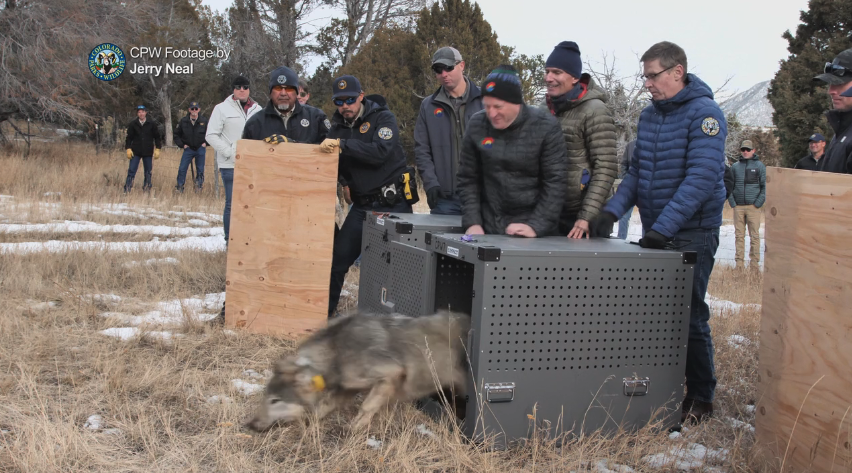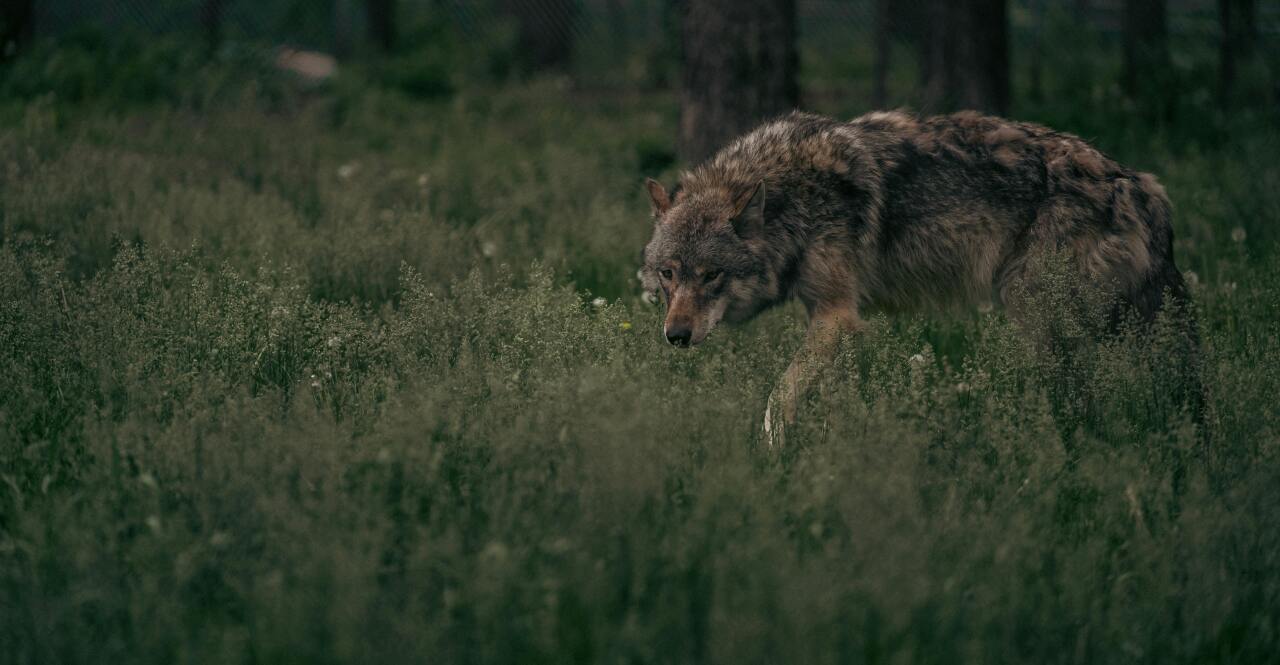DENVER — After a previous agreement fell through, Colorado has secured a source location for the second round of gray wolf reintroductions, which will begin this winter.
Colorado Parks and Wildlife (CPW) announced on Friday that it had reached an agreement with the British Columbia Ministry of Water, Lands and Resource Stewardship in Canada. Between December 2024 and March 2025, up to 15 wolves will be captured from the Canadian province and translocated to Colorado.
"We are grateful to the B.C. Ministry of Water, Lands and Resource Stewardship for working with our agency on this critical next step in reintroducing gray wolves in the state," said CPW Director Jeff Davis in a press release. "Their willingness and ability to work with another jurisdiction to support our conservation priorities, as they have in past translocation efforts, demonstrates their long-shared commitment to seeing this species succeed."
Davis signed the agreement last week, he told Denver7 in an exclusive Friday morning interview.
While Canada was not listed as a possible source location in the Colorado Wolf Restoration and Management Plan, Davis said it wasn't necessarily an unexpected option.
"These source areas that we're going to are the source areas that were utilized for the Yellowstone restoration and the Idaho restoration. And quite frankly, they're the same genetic lineage of all the wolves in the western states," Davis said in our interview. "And so given the population size in Oregon, where we sourced last year, given the state listing status of Washington's population and our inability to go to Idaho, Montana or Wyoming for sourcing — it really led us to the origin of western states' wolf populations from British Columbia."
The province is home to about 8,500 wolves, but that number fluctuates year to year, according to British Columbia's website.
British Columbia is home to wolf packs that thrive in areas with little to no livestock presence, Davis said, which lines up with Colorado's efforts to ensure the wolves it translocates do not have a concerning depredation history.
The previous source location arrangement was announced in January 2024, when CPW said that the Confederated Tribes of the Colville Reservation had agreed to give Colorado 15 wolves from the tribal lands in northeastern Washington. But the offer was rescinded, CPW announced in early August, because the tribe "expressed some concerns regarding tribal relations." At the time, Davis said the decision was disappointing, but noted the agency had a strong relationship with the tribes and hoped to continue the discussions moving forward.

State
Washington Tribe rescinds gray wolf offer, CPW to search for more sources
In the wake of the rescindment, he added that CPW would continue to work with other potential sources for wolves.
That effort was rewarded in September, when CPW reached the agreement with the British Columbia Ministry of Water, Lands and Resource Stewardship.
Davis said despite the previous agreement with Washington falling through, he feels "pretty strong" about this new agreement with British Columbia.
"I could say, at least from my participation in those conversations, that they were pretty enthusiastic," Davis told Denver7. "You know, they're trying to balance a healthy wolf population in their province with caribou recovery efforts up there, and working very closely with their First Nations and trying to be respectful of their First Nations."
He said the First Nations hold ceremonies to celebrate Canada's caribou, and protecting their dwindling population is extremely important. Allowing Colorado to take some of the wolves for its restoration effort will help them reduce the numbers of depredations on the small caribou herds that the First Nations are working to recover, Davis said. The province reported that 37% of all adult caribou deaths are due to wolves.
British Columbia also has an abundant elk population, which are wolves' natural prey, so the sourced wolves will already recognize elk and deer as prey once they arrive in Colorado, Davis said. Colorado has a healthy elk population — 303,000 as of 2023 — and CPW is not anticipating any sort of similar recovery plan for those animals in Colorado, he added.
"We feel like these are going to be good sourcing for setting up both the wolves and the ranchers for success moving forward," Davis said.
The capture and transport operations will begin this winter, with help from biologists in British Columbia. Despite the geographical separation, gray wolves from the Canadian Rockies have no biological differences from the ones released in Colorado last year during the first round of reintroductions, CPW said.
Davis said the logistics of moving wolves across country lines is "truly complex" and they are working with British Columbia's technical team to identify the potential packs to source from.

Over the past few weeks, CPW has made several references to lessons learned from the first round of reintroduction efforts.
"A big lesson learned is spending more time with county electeds and the livestock producers in the areas that we anticipate those releases," Davis told Denver7. "Obviously, we haven't really honed into 'These are the specific release sites.' We have said very publicly that the animals this winter will go into that northern release zone, and again, we'll be in touch, just like we will be with the Copper Creek Pack release, with the county electeds and producers in that area."
That northern zone for the second round of reintroductions is pictured below.

Davis explained that moving forward, CPW will go into areas where wolves currently roam the landscape and where they plan to release the wolves, and will then work with ranchers to create "site vulnerability assessments" to identify any weak spots and the most effective coexistence techniques for that specific area.
"The site vulnerability assessments will utilize our expertise in identifying which non-lethal or coexistence techniques will be most applicable and effective for a particular area and a particular ranching operation," Davis explained.

Local
Colorado's wolf conflict coordinator and ranchers work to find common ground
In addition, more resources are going to become available to CPW with this winter's upcoming release, which can include more range riders, guardian dogs and other non-lethal methods that can cover more territory. The Western Landowners Association announced in December that five states, including Colorado, would receive more than $22 million thanks to two Regional Conservation Partnership Program grants to help livestock producers "remain economically viable and steward habitat in predator rich environments." Colorado is expected to have access to about $2 million of that total.
Davis said these funds will support non-lethal equipment and deployment over the next five years. The money for these cost-sharing tools will become available to the state this November, and CPW will apply to use it.
"So, I feel very good about all the work that's going into really strengthening those programs," he said. "There's a community education part of it too — how do we make it easy on the ranching community to coexist with these animals, to avoid and minimize the conflicts with their livestock and their livelihoods, quite frankly? So, I feel like we're in a much better place today than we were in the last release."
CPW has been working with the Colorado Department of Agriculture, U.S. Fish and Wildlife Service, Natural Resources Conservation Service's wildlife services and experienced non-governmental organizations (NGOs) "to really bolster our coexistence programs, greenline this some of the permitting process, as well as making the multiple pots of money more easily accessible to the ranching community," Davis said.
Some aspects of this upcoming reintroduction will stay the same as last year, when CPW captured wolves from Oregon to transport to Colorado:
- The wolves will be tested and treated for any diseases at the source site (Wolves with major injuries do not meet the requirements for reintroduction)
- The wolves will have GPS collars placed on them
- The wolves will be transported in sturdy crates to Colorado by airplane and/or truck
- The wolves will be released in Colorado as soon as possible to minimize stress
As with last year, Colorado will not translocate any wolves in packs that are known for repeated livestock depredations, CPW said.
You can watch Denver7's coverage from the first wolf release below.
CPW is responsible for all associated costs for the capture and transport.
Depending on how this second reintroduction progresses with British Columbia, Davis said "there's been some receptivity that this could be a beyond-this-winter opportunity for us moving forward."

All of this movement around wolves in Colorado is the result of the state's voter-mandated reintroduction effort.
In the 2020 election, Colorado voters had the chance to decide on Proposition 114, which mandated that CPW develop a plan to start reintroducing and managing gray wolves in western Colorado and to take steps to begin those reintroductions by Dec. 31, 2023. It passed with 50.91% of the vote, but with much of the "Yes" votes around the Front Range and most of the "No" votes outside of that area, with a few exceptions.

After two and a half years of Technical Working Group and a Stakeholder Advisory Group discussions, CPW published the finalized Colorado Wolf Restoration and Management Plan in May 2023, clearing the way for wolf reintroductions to start at the end of the year.
Per that plan, CPW released its first five gray wolves on Dec. 18, 2023 at an undisclosed place in Grand County. Five more were released a few days later in Grand and Summit counties.

Denver7 360 | In-Depth News
Grand County residents brace as gray wolf reintroduction process begins
The 261-page management plan lists the goal of translocating 10 to 15 gray wolves per year for a total of 30 to 50 wolves over three to five years. Davis said Colorado likely has two or three more years of releases ahead of it, given that CPW is trying to get the base population up to establish packs. After that point, the active reintroduction efforts will stop and CPW will focus solely on monitoring to see if the population is self-sustaining.
The reintroduction will be considered successful if the survival rate is high, the wolves stay in Colorado, packs are formed and breed, and if wolves born in Colorado survive and reproduce, according to the plan.
Read the full wolf restoration and management plan below or here.
Currently, Colorado is home to nine known adult wolves — two that moved naturally to Colorado and seven of the original 10 that were introduced in December — and four pups. The pups were born this year and were part of the Copper Creek Pack capture, which was spurred by multiple livestock depredations. CPW said they hope to release the pups together once they reach adult size, so they can hunt as a group.
Three adult wolves that were reintroduced have died. One was apparently attacked by a mountain lion, one was found in poor condition ahead of capture to relocate the Copper Creek Pack and a third was found dead on Sept. 10 in Grand County of an unknown cause.
"Wolf survival is highly variable between regions, but three of the 12 wolves in Colorado (10 translocated wolves and two that remained in Colorado) dying in nine months is not cause for alarm and is in line with typical wolf survival," Travis Duncan, public information officer with CPW, told Denver7 on Thursday.
Per the Colorado Wolf Restoration and Management Plan, CPW listed the primary causes of wolf mortality as infectious disease, starvation and intraspecific strife, where the same species competes for limited resources and can attack each other.








